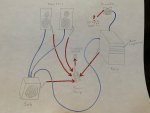cyberdaniel82
New member
Hi! I’m hoping to receive a suggestion or two for chasing down and/or mitigating 60-cycle hum in my signal chain.
I have a Belkin power strip plugged into a grounded outlet. All of my gear - including my rack - plugs into the Belkin. My rack includes a power conditioner and an RME UFX+ interface.
I purchased a single active Avantone MixCube for mixing in mono. The MixCube receives signal from a verified good TRS cable connected to the RME UFX+. No matter what outlet I use to plug in the MixCube’s power supply (Power strip, Power conditioner, or two different wall outlets), I get some 60-cycle hum out of my two main monitors. (If I flip the ground switch on the MixCube, I get major hum out of only the MixCube). I’ve confirmed that a) it’s a 60 cycle hum, not 120, b) the hum goes away if I put a ground lift on the MixCube’s power plug, and c) the hum goes away if I disconnect the TRS connection between my RME UFX+ and the MixCube. I’ve included a crude visual diagram and a picture of my space (the cables are not usually as haphazard).
A two-pronged ground lift fixes the problem, but… my understanding is that leaving a two-pronged ground lift in place is a poor/dangerous long-term practice. I’ve seen products like the Ebtech Hum-X which seem like perhaps they’d constitute a solution. I figured I’d ask the forum for advice before going that route, though. Any advice would be greatly appreciated!
- Daniel


I have a Belkin power strip plugged into a grounded outlet. All of my gear - including my rack - plugs into the Belkin. My rack includes a power conditioner and an RME UFX+ interface.
I purchased a single active Avantone MixCube for mixing in mono. The MixCube receives signal from a verified good TRS cable connected to the RME UFX+. No matter what outlet I use to plug in the MixCube’s power supply (Power strip, Power conditioner, or two different wall outlets), I get some 60-cycle hum out of my two main monitors. (If I flip the ground switch on the MixCube, I get major hum out of only the MixCube). I’ve confirmed that a) it’s a 60 cycle hum, not 120, b) the hum goes away if I put a ground lift on the MixCube’s power plug, and c) the hum goes away if I disconnect the TRS connection between my RME UFX+ and the MixCube. I’ve included a crude visual diagram and a picture of my space (the cables are not usually as haphazard).
A two-pronged ground lift fixes the problem, but… my understanding is that leaving a two-pronged ground lift in place is a poor/dangerous long-term practice. I’ve seen products like the Ebtech Hum-X which seem like perhaps they’d constitute a solution. I figured I’d ask the forum for advice before going that route, though. Any advice would be greatly appreciated!
- Daniel


